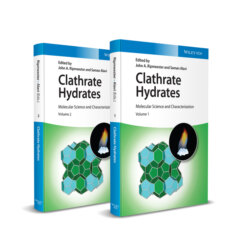Читать книгу Clathrate Hydrates - Группа авторов - Страница 33
Notes
Оглавление1 1 Due to the same circumstance, these bodies are well suited for examining the changes that occur in physical properties of the two elements of a compound that forms by the mere fact of their contact. Indeed, the two components retain their identity within the compound; they preserve there a molecular state as close as possible to that which they possess in the state of freedom.
2 2 When a rapid flow of SO2 is passed through a solution, whereas elevation of the temperature up to 8° or 9° makes all of the (hydrate) crystals disappear, a slight lowering of temperature is sometimes enough to make them reappear. In this way I have seen them form at 3°, 4°, 5°.Messrs. Cailletet and Wroblewski mention a similar fact. According to these scientists, a simple compression is enough to re‐form the hydrates (which they were working with) shortly after they had disappeared. Mr. Cailletet assumed that in this case an infinitely small crystal remained in the tube. In the case of SO2 hydrate, however, it seems to me that this supposition is inadmissible because a hydrate crystal, however small it may be, will have already caused crystallization at 7°.Can one not assume: that shortly after dissociation of the solid hydrate, some aggregates of liquid molecules still have a favorable arrangement for the reformation, but which they lose later?
3 3 … for each new hydrate, the remaining task, therefore, is to determine numerical values corresponding to equilibrium; but the general laws are no longer unknown.
4 4 The experiments carried out by de Forcrand were not exhaustive. Today we know that boiling points (or melting points for solids) do not determine the suitability of materials to be hydrate guests. For instance, double hydrates with cyclooctane (b.p. 149 °C), iso‐amyl alcohol (b.p. 131.2 °C), hexachloroethane (m.p. 183–5 °C), and adamantane (m.p. 270 °C) as guests are known.
5 5 “In some cases I have noticed almost perfect octahedra. Moreover, examination with a polarized light microscope can leave no doubt as to the cubic form of these crystals, which do not act on polarized light.”
6 6 “… the resulting numbers show that the amount of heat generated is considerable, but it is mainly due to the change of state of the water that is in the compound.”
7 7 “... the presence of ice causes disturbances which are difficult to take into account, and which have prevented us here from obtaining consistent results.”
8 8 The dissociable compounds, which are stable only in the solid state, are formed of water with various gases, are all isomorphous to each other, crystallize in the cubic system, and have a constitution expressed by the general formula M + 6H2O where M designates a molecule of the gas under consideration.
